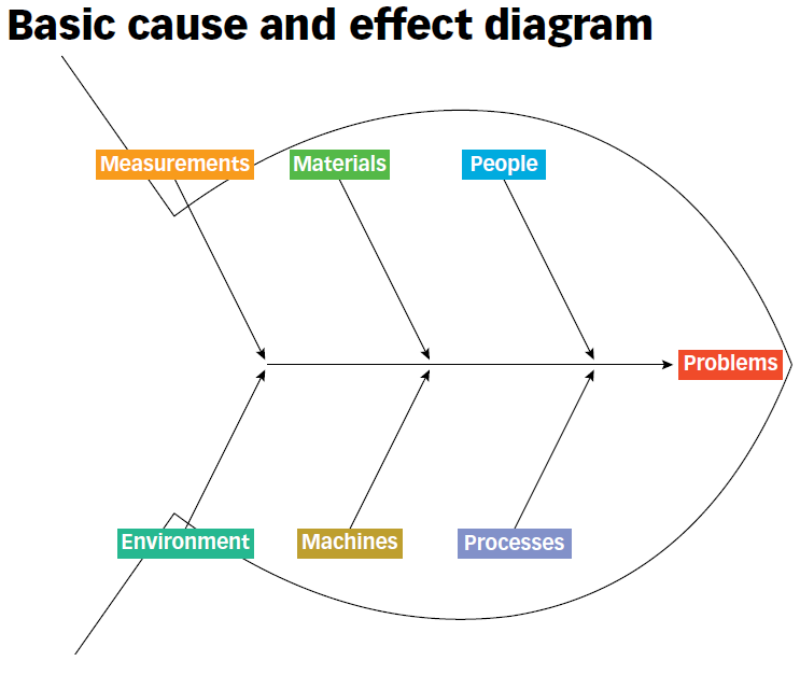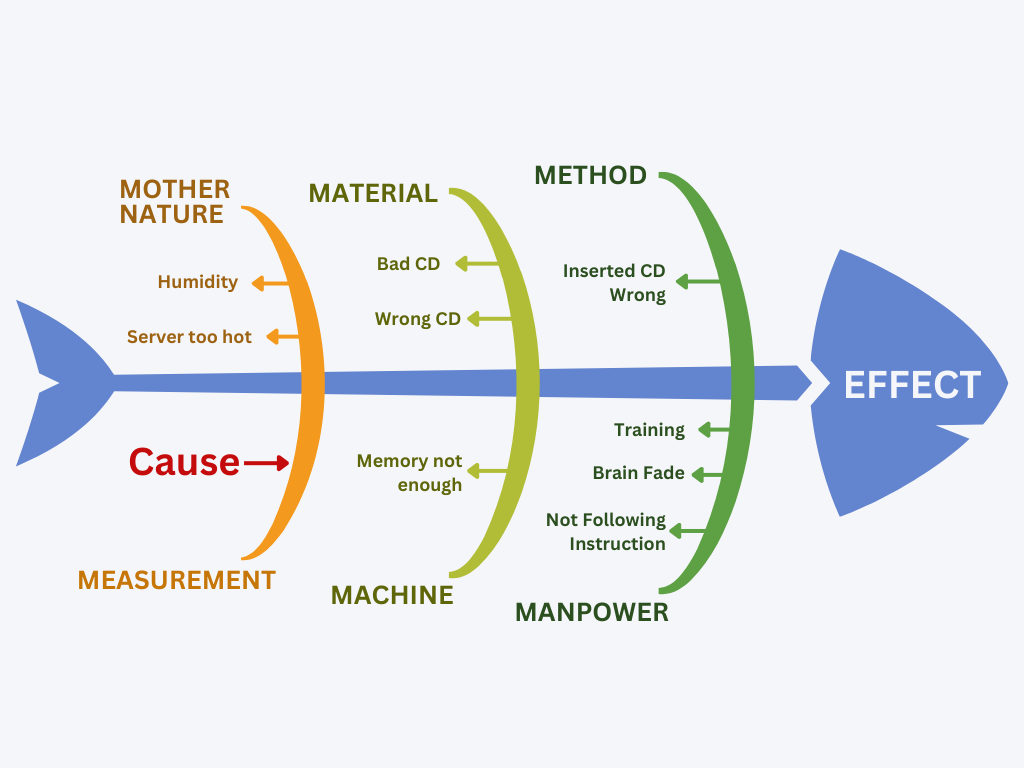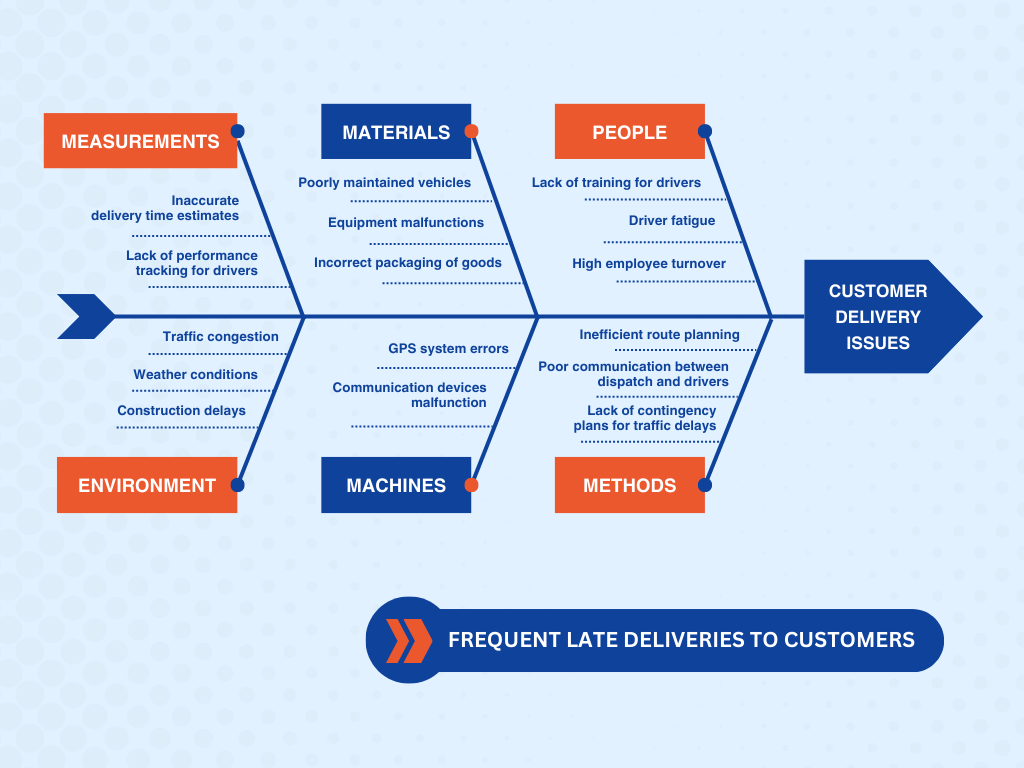A fishbone diagram template is one of the famous problem solving method that is used to find the causes of issues and explore remedies. It is also known as the Ishikawa Diagram or Cause-and-Effect Diagram. This diagram is commonly used at organizations when it comes to identify the possible causes of a specific problem by categorizing potential sources of issues. It’s a great tool for brainstorming and analysis, if you’re into problem solving then make sure to know more about fishbone diagram and see how well it works for you.
Why the name “Fishbone Diagram”? It’s because of the structure, this structure of this diagram resembles with a fish’s skeleton and that’s why its known as the Fishbone Diagram, this is how it looks like:

As you can see there are several key components in this diagram, so let’s understand the components of a Fishbone Diagram one by one,
- Head (Effect/Problem Statement): The issue or the problem is written at the head of the fishbone diagram.
- Spine (Main Line): This is a straight horizontal line that extends from the head, forming the backbone of the diagram.
- Major Categories (Branches/Ribs): On branches you write down the key categories which are contributing to the problem. Please note that 6Ms structure is followed for manufacturing or 4Ps for service industries.
- Causes (Sub-Branches): There are sub branches that extend from the major categories, each sub branch will list the potential factor that is contributing to the problem.
Contents
Why Fishbone Diagram is Used?
A fishbone diagram is primarily used to explore the potential cause of a problem or issue, identify the root causes, and explore the solutions. This diagram can be used at both individual and organization level. Companies and organizations often use a fishbone diagram to:
- Improve the quality of products or services by identifying the defects or inefficiencies in a process.
- It is used to analyze the root cause of a problem so the reasons behind recurring issues can be understood.
- It’s easier to make effective decisions once you have root causes of a problem in front of you.
- It takes a collaborative efforts to identify the root causes of a problem or issues, it encourages team collaboration.
Not only at company level, you may use a fishbone diagram to analyze your personal life problems as well. Each problem has a root cause, you will be able to work on a solution once the root cause is known. Every person must know how to use a fishbone diagram in order to enhance their problem solving skills.
Following are some of the Challenges that you may face with Fishbone Diagram
Each powerful problem solving method has it’s own limitation and Fishbone Diagram is no exception, following are some of the Challenges that you may face with Fishbone Diagram.
- It does not provide Solutions, this tool is used to find the root causes and you have to work on the solution part.
- At organization levels, it takes efforts from team to find the root causes, team brainstorming is required to find the possible causes.
- For many problems, you may need to go beyond this diagram because certain complex issues require deeper analysis beyond a simple diagram.
Download Fishbone Diagram Template


Best Ways to Use a Fishbone Diagram
Save you time and download a pre-made fishbone diagram instead of creating it from scratch and do the following to increase the effectiveness of a Fishbone Diagram:
- Make sure to Clearly Define the Problem. The Problem should be very clear to everyone who’s working so possible causes can be find accordingly.
- It’s better to have a team of right people instead of working alone. Involve team members with relevant expertise.
- Brainstorming is the key for finding causes. Open discussion should be encouraged
- You can’t just write any random cause. Each cause should be validated with data and evidence.
- Make sure to review the fishbone diagram and revise as needed
Alternatives of Fishbone Diagram
There are many alternatives of Fishbone Diagram such as:
- The 5 Whys,
- a Pareto chart,
- or a fault tree analysis
Conclusion
Using a Fishbone diagram template is one of the most effective ways to find the root causes of a certain problem. This tool is commonly used at organizations when it comes to identify and address the causes of a problem and find a solution. The whole purpose of using a fishbone diagram is to find root causes and improve the efficiency and quality of a product or services. There are different industries where this diagram is used such as manufacturing, healthcare, service, or project management, etc. Fishbone Diagram remains a fundamental tool for effective problem-solving and quality control.
